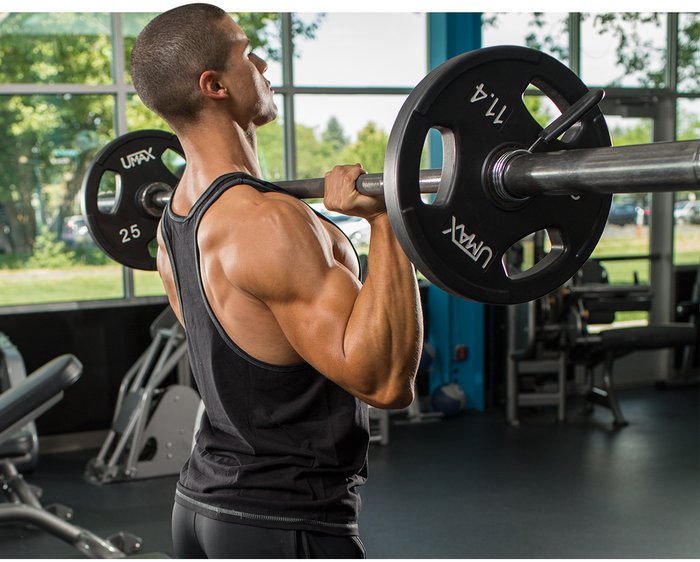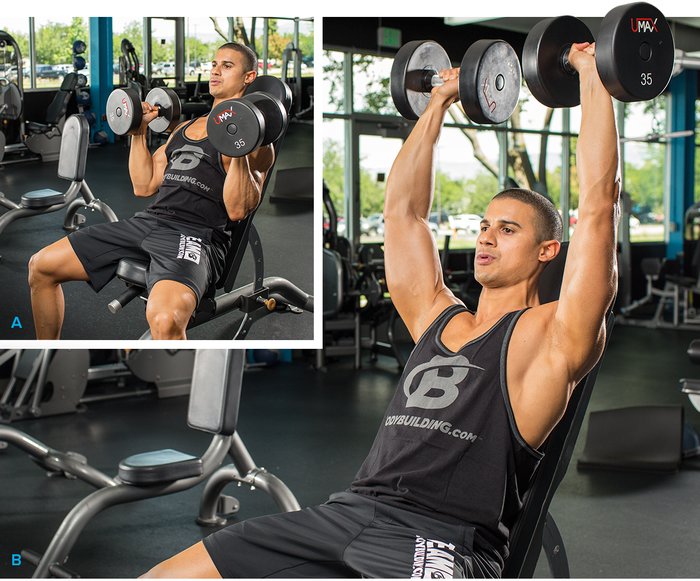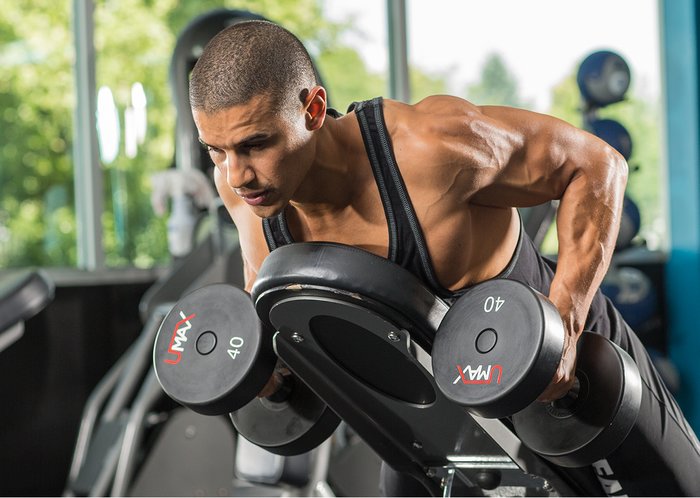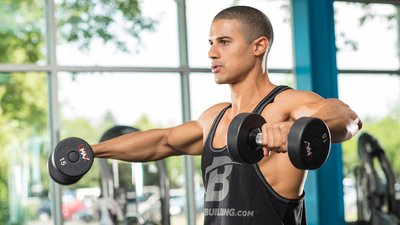Training canon suggests you construct a mass-building shoulder workout according to a simple formula: a big multijoint lift first, followed by single-joint movements for each of the three delt heads. That's a winning recipe for many beginners and intermediate lifters, but when the shoulders in question are those of an advanced lifter like WBFF pro fitness model and body transformation coach Lee Constantinou, rules can go out the window.
Constantinou's preferred way of flipping the script is to use pre-exhaust training, where you perform a single-joint exercise (like leg extensions on leg day or chest flies on chest day) before a multijoint movement (say, squats or bench). Doing that before one exercise is a common technique to ensure that your target muscle gets adequately worked, even with a lighter weight. But Constantinou doesn't stop at one move.

Seated Bent-Over Rear Delt Raise
"Instead of doing just one single-joint exercise first in my workout, I do one before every multijoint exercise," says Constantinou. "Both single-joint and multijoint movements involve the same delt head, and I do it with the fronts, middles, and rears. It simply makes every multijoint harder, and you'll likely have to come down in weight as a result. For anyone who has ever forgotten what DOMS feels like in the delts, you'll soon discover why this protocol is so effective."
Let's take a look at Constantinou's shoulder-blast workout before getting into the finer points of the routine.
Shoulder Blast Workout
- Do as many warm-ups as you need, but never take warm-up sets to muscle failure.
- Choose the resistance based on the target rep; you should reach muscle failure by the rep listed. Adjust the weight accordingly if not.
- The multijoint movements follow an ascending pyramid, meaning you increase the weight on successive sets for a lower rep target.
- Don't think of the pre-exhaust pairings as supersets. Do all sets for each move in order.

BodyFit
$6.99/month- 2,500+ expert-created single workouts
- 3,500+ how-to exercise videos
- Detailed workout instruction
- Step-by-step workout tips
- Training at gym or at home
- Access to Workout Plans
- Access to Bodyfit App
- Store Discounts
Already have a Bodybuilding.com account with BodyFit? Sign In

What comes with BodyFit?

- Instructional Videos
Don't risk doing a workout improperly! Avoid injury and keep your form in check with in-depth instructional videos.

- How-to Images
View our enormous library of workout photos and see exactly how each exercise should be done before you give it a shot.

- Step-by-Step Instructions
Quickly read through our step-by-step directions to ensure you're doing each workout correctly the first time, every time.
Details of the Shoulder Blast
As with any advanced training program, what makes it sing is in the details rather than just a list of exercises, sets, and reps. Let's take a closer look at what's going on here, movement by movement.
Lateral Raise
Constantinou does the first movement as a warm-up, with a small-but-crucial tweak to make it harder. "I hold the top position for a full count rather than allowing the weight to drop right away," he says. "Both the high reps and isometric hold work the middle delts especially well, and I find it even improves my mind-muscle connection. You may have to decrease the weight you're using, because the static hold requires a great deal of extra effort."
Standing Military Press
After the lateral raises, you may not be able to push heroic weights on the press. That's fine. "The standing position allows for a bit more momentum, but don't turn this into a push-press," he advises.

Standing Military Press
He also switches into an ascending pyramid scheme, increasing the weight on each successive rep target. Only the last set should be taken to complete muscle failure.
Lying Front Incline Dumbbell Raise
Constantinou takes aim at the front delts with another isolation move. And once again, he finds a way to make his single-joint movement even harder, this time by taking a seat. "I do the common front-raise movement by lying back against an incline bench, which reduces my ability to recruit momentum," says Constantinou. "I like the hammer grip [also called neutral grip] because I feel it better isolates the front delts. Again, a high-rep target ensures I'm really feeling it."
Neutral-Grip Rotating Dumbbell Shoulder Press
This is similar to an Arnold press, but starting with a neutral grip rather than with your hands facing you. Constantinou prefers to perform it with his body supported against a steep incline bench as well. "Note the hand position at the start; my elbows are pulled way forward," he says. "Compare that to the elbow position on military presses, where my [upper] arms go directly out to my sides. That forward elbow position better recruits the front delts while decreasing the activity on the middles."

Neutral-Grip Rotating Dumbbell Shoulder Press
Again, he follows an ascending pyramid, taking only his last and heaviest set to muscle failure.
Seated Bent-Over Rear Delt Raise
"Not only will your delts be highly fatigued by now, but doing the rear-delt raise seated means you'll have to cut back on the weight even more," says Constantinou. "I typically include an isometric hold at the top here, to boost intensity, but even that might be too difficult for many people at this point in their workout."
Dumbbell Incline Row
No, that isn't a misprint. There's good reason to end this shoulder day with a back move. A 2014 EMG analysis suggested multijoint shoulder exercises don't recruit the rear-delt musculature as well as some multijoint back exercises.[1] This is one reason many pro bodybuilders train their rear delts after a back session.

Dumbbell Incline Row
Once again, Constantinou isn't content to find any easy ways out. He's back to his ascending pyramid, but once he reaches muscle failure on his last set he adds a pair of dropsets so that he ultimately reaches muscle failure three times over the course of a single set. "Once you reach failure, which should be about the 10th rep, reduce the weight by about 25 percent and immediately go again until failure. You'll do that one more time, which enables you to reach 30 reps on your final set, a super-intense way to finish your workout."
Like any novel training program, Constantinou says this approach can be highly effective for an intermediate-level-or-beyond bodybuilder for about 6-8 weeks. As adaptation takes place, it's time to again change up the training stimulus. Try this unique approach, and let us know how it works in the comments!
Bet Sellers For Muscle Growth
References
- Sweeney, S. (2014) Electromyographic analysis of the deltoid muscle during various shoulder exercises (doctoral dissertation, University of Wisconsin, La Crosse).




